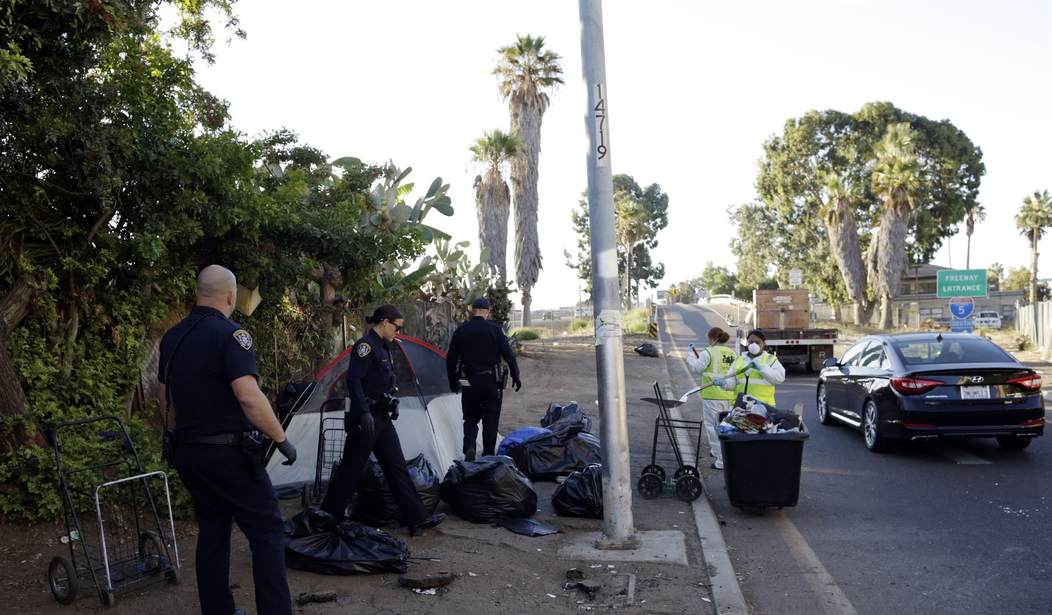In June, the San Diego City Council passed a controversial ordinance targeted at addressing the homeless population exploding on their streets.
The San Diego City Council voted 5-4 on June 13 to adopt a controversial policy to ban homeless encampments on public property after hearing hours of public testimony.
The ordinance, proposed by Councilman Stephen Whitburn, was supported by him and council members Joe LaCava, whose District 1 includes La Jolla, Marni von Wilpert, Jennifer Campbell and Raul Campillo.
Mayor Todd Gloria also supported what backers referred to as an unsafe-camping ordinance, with Gloria and Whitburn saying it would address a public safety issue while helping to get homeless people off the streets and into a shelter and connected to services.
The city hadn’t reached LA or San Francisco proportions of squalor, danger, and degeneracy yet, but they were well on their way. Businesses were under constant assault…
A San Diego bakery is locking its doors during business hours after a string of incidents involving homeless individuals entering the shop and wreaking havoc.
The owners of Phattie’s Bake Shop say they have had run-ins with people damaging property, stealing food, and even one incident where a man entered with a crowbar.
An Instagram post on Friday showed a photo of a man with the weapon along with a caption explaining that a doorbell service would be used going forward.
The post has received hundreds of likes and dozens of comments from supporters who empathized with the owner’s decision to lock down for safety reasons.
San Diego has more than 2,000 individuals living on the streets. In 2019, the county had the fourth-highest population of unhoused individuals in the United States.
…and harassed residents were increasingly unable to do something as simple as safely ride a bike on city streets.
Women gets bike stolen in San Diego in broad daylight on 8/5/2023 #biketheft #homeless #lawless #sandiego #watchyourback #buildbackbetter pic.twitter.com/JHDihCZ7VN
— Red Wave (@joinredwave) August 8, 2023
Police began enforcement at the end of July. Non-profits and homeless advocates noticed something curious. Many of the former street regulars vanished.
…Murals along Commercial Street in downtown San Diego have long been blocked by encampments. Yet at the start of the week, no tents could be seen on either side of the road. The same went for the people who’d been living in them.
“There were hundreds,” Bob McElroy, president and CEO of the Alpha Project shelter, said in an interview. “Where did they go?”
…The “Unsafe Camping Ordinance” allows officers to force people off public land if they’re sleeping within two blocks of a school, shelter, trolley station, waterway or park “where a substantial public health and safety risk is determined.”
…He was especially surprised by how empty Commercial Street was, and the CEO said outreach teams were still surveying the city. “They’re scramblin’ around to figure out where everybody went.”
Commercial Street had once been so clogged that tents and tarps spilled onto the road. Yet at one point Monday, the only movement came from a pair of officers crossing the road. One said in passing that the encampment had been cleared a few days ago.
City and police representatives said that change had nothing to do with the camping ban. Although a new “No Camping” sign is on Commercial, a prerequisite to enforcement, officials said the road was cleared because of existing laws against blocking streets, not the result of a special operation.
Even before the ban took effect, one survey found the number of homeless people downtown had dropped by almost a fifth, potentially because of the coming enforcement.
San Diego had 1758 beds for a homeless population estimated at about 6500. Many of those people didn’t bother asking about beds, even though “homeless advocacy” is big business, and finding them a bed is what they make bank on. Many vagrants simply packed up and headed to Chula Vista, a neighboring community…
…One homeless services provider said there’s been a rush of people experiencing homelessness coming down from San Diego to South Bay.
Many are looking for food, shelter, showers and other services at organizations like Community Through Hope.
“Three weeks before San Diego’s ban went into effect on camping, and now three weeks in we’ve seen a massive influx of people from the city of San Diego right here (in) Chula Vista,” said Sebastian Martinez, executive director of the Chula Vista non-profit, which is one of South Bay’s largest homeless service providers.
…which is now considering passing a similar ordinance. The influx has been overwhelming the shelter facilities and services they have.
…Chula Vista Mayor John McCann said he’s aware of the increase in people accessing homeless services, and the city is considering a similar approach to San Diego to address the situation.
San Diego is in a fight with some of their contracted shelter providers in the city over what should be the criteria for being on a suspension list – in otherwards denied access – to a shelter. And if you’re put on one, how long should that homeless individual stay on it. And why are blacks over represented on the lists? Conversely, the folks running the shelter have serious concerns about the safety of their volunteers, and point out that the city administrators can talk about de-escalation all they want, but when an individual pulls a knife in the facility, it’s not the city employees in danger.
It’s a mess.
…Fischle-Faulk and Housing Commission Vice President Casey Snell responded in a July 19 letter noting that the city’s housing agency has invested significant time trying to work with Father Joe’s and hired an outside consultant to try to address disparities.
“FJV’s lack of accountability and unwillingness to move forward in a cooperative and collaborative manner, as reflected in the July 11, 2023, responses, is disappointing,” Fischle-Faulk and Snell wrote.
Father Joe’s Villages told Voice that seven people recently banned from its shelters had physically assaulted someone, brandished weapons, damaged an apartment, stabbed someone and threatened to shoot clients and staff.
The shelter issue can be the most difficult nut to crack though, because even if facilities are available, there’s a very good chance a large percentage of the homeless will disappear rather than take advantage of the opportunity.
San Diego now enforcing homeless camping ban –
Key pts:
1. homeless respond to incentives like anyone: announcement of a future ban rapidly cleared out problem areas.
2. No shelters needed: none accepted offers of shelter.
3. Support NGOs are no help https://t.co/1IZ2HAG4gI— Ertist (@Ertist) August 16, 2023
…On Thursday, the city’s Department of Emergency Management released new data gathered by its Healthy Streets Operations Center.
In 2023, HSOC teams approached and engaged with 2,344 unsheltered people living on the streets. Of those 2,344 people, 1,065 accepted shelter services. Fifty-four percent of people experiencing homelessness — or 1,278 people — declined offers for shelter.
“We’ve also found that 153 had some form of shelter or housing, but were still living in encampments,” Francis Zamora of SFDEM told KRON4.
“No, thanks, doin’ fine.” Because you built it doesn’t mean they will come.
And, in San Diego’s case, it seems like they’ve moved along.
What it will take is the neighboring cities to do what Chula Vista is being forced to do – the exact same thing.
Or risk becoming a San Francisco-style homeless sanctuary city.







Join the conversation as a VIP Member